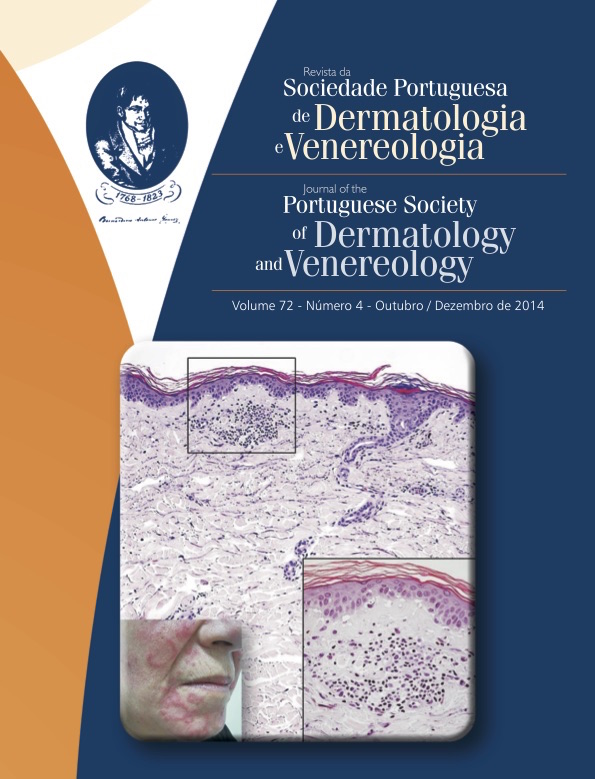SARCOMA DE KAPOSI - REVISÃO CLÍNICO-PATOLÓGICA
Resumo
Introdução: O Sarcoma de Kaposi (SK) é uma afecção sistémica, cuja natureza neoplásica ou reactiva é controversa, que parece ter como origem a célula endotelial linfática e tem como agente etiológico o vírus herpes humano tipo 8 (HHV8). Existem 4 subtipos clínicos: clássico, epidémico, endémico e iatrogénico.
Objectivos, material e métodos: Revisão retrospectiva dos processos clínicos e preparações histológicas dos casos de SK diagnosticados entre Janeiro de 2001 e Dezembro de 2013, nos departamentos de Dermatopatologia do Hospital Egas Moniz e Centro de Dermatologia Médico-Cirúrgica de Lisboa e avaliar diferenças entre os vários tipos.
Resultados: Incluiu-se um total de 91 doentes, dos quais 67,0% correspondiam a SK clássico; 30,8% a SK epidémico; 1,1% a SK endémico e 1,1% a SK iatrogénico. Verificou-se que 85,7% dos doentes eram do sexo masculino e 14,3% do sexo feminino, sendo que este predomínio ocorreu em todas as variantes. A média de idades dos doentes com SK epidémico foi inferior ao SK clássico (37,3 vs 70,0 anos, p<0.001). Os membros inferiores foram a localização preferencial de todas as variantes (74,2%). Histologicamente, nos doentes com SK clássico, verificou-se um predomínio do estádio nódulo (62,3%), enquanto no SK epidémico o estádio mais comum foi placa (46,4%), sendo esta diferença quase estatisticamente significativa (p= 0,057). Não se observaram diferenças nos vários estádios histológicos nos diferentes subtipos clínicos.
Conclusões: As diferenças observadas no SK epidémico parecem relacionar-se mais com alterações subtis, inerentes a lesões precoces, em vez de diferenças únicas desta variante, o que está de acordo com a literatura.
Downloads
Referências
Schwartz RA, Micali G, Nasca MR, Scuderi L.Kaposi Sarcoma: A continuing conundrum. J Am Acad
Dermatol. 2008;59(2):179-206.
Radu O, Pantanowitz L. Kaposi sarcoma. Arch Pathol Lab Med. 2013; 137(2):289-94.
Esteves TC, Moura C, Rafael M, Sachse MF, Rosa JC, Rafael A, et al. Estudo epidemiológico dos doentes
com Sarcoma de Kaposi. Trab Soc Port Dermatol Venereol 2010; 68 (3): 373-9.
Dittmer DP, Damania B. Kaposi sarcoma associated herpesvirus pathogenesis (KSHV)-an update. Curr
Opin Virol. 2013; 3(3):238-44.
Satter EK. Kaposi sarcoma. Cutis. 2013;91(3):120, 123-4.
Chor PJ, Santa Cruz DJ. Kaposi's sarcoma. A clinicopathologic review and differential diagnosis. J
Cutan Pathol. 1992; 19(1):6-20.
Daly, ML, Fogo A, McDonald C, Morris-Jones R. Kaposi sarcoma: no longer an AIDS-defining illness? A retrospective study of Kaposi sarcoma cases with CD4 counts above 300/mm3 at presentation. Clin Exp Dermatol. 2014; 39: 7-12.
Calonje E, Brenn T, Lazar A, Mckee P. Kaposi´s sarcoma. In: Calonje E, Brenn T, Lazar A, Mckee P,
editors: Mckee´s Pathology of the Skin with clinical correlations. Amsterdam: Elsevier Saunders; 2012.
p.1729-1734.
O´Donell PJ, Pantanowitz L, Grayson W. Unique histologic variants of cutaneous Kaposi sarcoma. Am J Dermatopathol. 2010; 32(3): 244-50.
Grayson W, Pantanowitz L. Histological variants of cutaneous Kaposi sarcoma. Diagn Pathol. 2008;
;3:31.
Todos os artigos desta revista são de acesso aberto sob a licença internacional Creative Commons Attribution-NonCommercial 4.0 (CC BY-NC 4.0).








